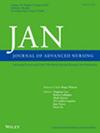学龄前儿童先天性心脏手术后电子健康心脏康复计划的有效性:一项随机对照试验。
IF 3.4
3区 医学
Q1 NURSING
引用次数: 0
摘要
目的:开发基于客户健康行为互动模型的学龄前儿童电子健康心脏康复方案,并评估其对先天性心脏手术后儿童的影响。设计一项平行双臂随机对照试验。方法于2022年7月至2023年6月共招募84名受试者,随机分为干预组(n = 40)和对照组(n = 44)。干预组接受为期3个月的eHealth心脏康复计划,对照组接受常规护理。在基线、基线后3个月(干预终点)和基线后6个月测量结果。80名参与者完成了这项研究。结果与干预组相比,对照组在3个月和6个月时的预后均明显较差,包括心力衰竭风险较高,左心室射血分数评分较低,6分钟步行距离测试较短。干预组参与了更剧烈的体育活动。在父母的知识、态度、行为和信任水平上,组间也存在显著差异。此外,在基线后6个月,干预组经历焦虑的父母比例显著下降。结论:这项开创性的电子健康计划改变了学龄前先天性心脏病儿童的家庭康复,解决了可获得和长期儿科心脏康复护理的关键空白。对专业和/或患者护理的影响电子保健方案的使用对改善儿科心脏康复很有价值,它赋予父母权力,增强护理的连续性,减少获得儿科护理专业服务的障碍,特别是在医疗资源有限的地区。本研究为先心病手术后学龄前儿童以家庭为中心的心脏康复建立了第一个经过验证的电子健康框架,解决了以前以家庭为基础的康复使用率极低的问题。它还为临床医生提供了一个可扩展的解决方案,以便在缺乏专业心脏服务的服务不足地区提供护理。报告方法本研究遵循CONSORT随机对照试验报告清单指南。患者或公众的贡献本研究的设计、实施或报告中没有患者或公众的参与。试验和方案注册本研究是一项随机对照临床试验。本研究方案已在中国临床试验注册中心注册(注册号:ChiCTR2200062022; https://www.chictr.org.cn/showproj.html?proj=174261)。本文章由计算机程序翻译,如有差异,请以英文原文为准。
Effectiveness of the Preschool Children eHealth Cardiac Rehabilitation Program After Congenital Heart Surgery: A Randomised Controlled Trial.
AIM(S)
To develop the Preschool Children eHealth Cardiac Rehabilitation programme based on the Interaction Model of Client Health Behaviour, and to evaluate its effects on children after congenital heart surgery.
DESIGN
A parallel two-arm randomised controlled trial was conducted.
METHODS
A total of 84 participants were recruited from July 2022 to June 2023 and randomly assigned to either the intervention group (n = 40) or control group (n = 44). The intervention group participated in a 3-month eHealth Cardiac Rehabilitation programme, while the control group received routine care. Outcomes were measured at baseline, 3 months post baseline (intervention endpoint), and 6 months post baseline. Eighty participants completed the study.
RESULTS
Compared to the intervention group, the control group demonstrated significantly worse outcomes at both 3 and 6 months, including a higher risk of heart failure, lower left ventricular ejection fraction scores, and shorter 6-min walk distance tests. The intervention group engaged in significantly more vigorous physical activity. Significant between group differences were also observed in parental knowledge, attitudes, behaviours and trust levels. Additionally, the proportion of parents experiencing anxiety decreased significantly more in the intervention group by 6 months post baseline.
CONCLUSION
This pioneering eHealth programme transforms home-based rehabilitation for preschool children with congenital heart disease, addressing a critical gap in accessible and long-term paediatric cardiac rehabilitation care.
IMPLICATIONS FOR THE PROFESSION AND/OR PATIENT CARE
The use of eHealth programmes is valuable for improving paediatric cardiac rehabilitation by empowering parents, enhancing care continuity, and reducing barriers to accessing specialised services in paediatric care, especially in areas with limited medical resources.
IMPACT
This study establishes the first validated eHealth framework for family-centred cardiac rehabilitation in preschool children following congenital heart surgery, addressing the critically low uptake of previously home-based rehabilitation. It also provides clinicians with a scalable solution for delivering care in underserved regions lacking access to specialised cardiac services.
REPORTING METHOD
This study adhered to the CONSORT checklist guidelines for reporting randomised controlled trials.
PATIENT OR PUBLIC CONTRIBUTION
This study did not include patient or public involvement in its design, conduct, or reporting.
TRIAL AND PROTOCOL REGISTRATION
This study was a randomised controlled clinical trial. The research protocol was registered with the China Clinical Trial Registration Center (registration number: ChiCTR2200062022; https://www.chictr.org.cn/showproj.html?proj=174261).
求助全文
通过发布文献求助,成功后即可免费获取论文全文。
去求助
来源期刊
CiteScore
6.40
自引率
7.90%
发文量
369
审稿时长
3 months
期刊介绍:
The Journal of Advanced Nursing (JAN) contributes to the advancement of evidence-based nursing, midwifery and healthcare by disseminating high quality research and scholarship of contemporary relevance and with potential to advance knowledge for practice, education, management or policy.
All JAN papers are required to have a sound scientific, evidential, theoretical or philosophical base and to be critical, questioning and scholarly in approach. As an international journal, JAN promotes diversity of research and scholarship in terms of culture, paradigm and healthcare context. For JAN’s worldwide readership, authors are expected to make clear the wider international relevance of their work and to demonstrate sensitivity to cultural considerations and differences.

 求助内容:
求助内容: 应助结果提醒方式:
应助结果提醒方式:


